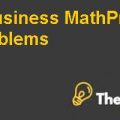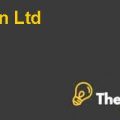
I. CASE # 1: Should the Industrial Products Group of LOCTITE Corporation introduce the new, “Adhesive Dispensing System”?
a. CUSTOMER ANALYSIS
Market share of adhesives was held high by LOCTITE, versus its two major competitors EASTMAN KODAK and PERMABOND. LOCTITE’s SUPERBONDER Adhesives captured a market share of 34.64%, which led the industry market share for CYANOACRYLATES, and Quick Set 404 to maintain a market share of 5.36%. It was seen that the market trends were moving in favor of LOCTITE as sales from CYANOACRYLATES were growing by 20% annually and that of the industrial segment at a much faster pace by 26.4%. Moreover, inter-industry sales of LOCTITE’s SUPERBONDER adhesives were seen to grow by 47.4% within one year, from fiscal year 1977 to fiscal year 1978. This was a clear indication that LOCTITE’s SUPERBONDER was aggressively capturing the market share from two of its major competitors and it was also pursuing an aggressive strategy in attracting potential new users. Furthermore, it is estimated that if LOCTITE sustained this growth, then it would encounter no problem in capturing the target market that it intends to capture. This would help LOCTITE to increase its sales by 30.81% in Fiscal Year 1979 to $4.5M as mentioned in LOCTITE’s case.
The Industrial segment for CYANOACRYLATES is a highly fragmented segment in the Adhesive Industry. The firm size was found to be a poor predictor of CYANOACRYLATES’ demand in the target market and at present, LOCTITE’s SUPERBONDER was giving major chunk of sales (approximately 50% of the total IPG’s sales). These sales were carried out by 285 trusted distributors of LOCTITE out of the total 10,000 distributors nationwide. These 285 distributors were either small or medium Original Equipment Manufacturers (OEMs), who accounted for almost 55% of the total volume (industrial) and in 16 Standardized Industrial Classification Groups, the usage of instant adhesives was more than 10%.
The development of BOND A MATIC was a result of the problems faced by most of the assembly line workers, who used to use the earlier version of adhesive. The difficulties faced were dispensing-off the CYANOACRYLATES from the proposed one-ounce and smaller bottles standard. BOND A MATIC was a solution to this problem, and it helped end-users to efficiently dispense-off, dots, dashes, or lines of adhesive from a relatively easy method without creating mess. To seize this opportunity, LOCTITE planned manufacturing BOND A MATIC, with an aim to cater the needs of the target market and also to expand its market share further. With a young aggressive player in the market, LOCTITE initiated efforts to educate end-users of the potential uses and many applications of LOCTITE’s SUPERBONDER. As BOND A MATIC was priced low, it might distort LOCTITE’s quality image in the mind of consumer and therefore it is advisable that LOCTITE’s BAM 2000 must be introduced as a compliment to LOCTITE’s SUPERBONDER Adhesives. For achieving a target purely based on maximizing benefits, usage and decision processes, LOCTITE needed to concentrate much on plant and production engineers as well, other company’s major directors from the Standard Industrial Classification Groups that lie in between 35-39, that use at least nine pounds of instant adhesives annually. According to the current industry estimates, this segment currently includes 8,997 firms that will grow at a good velocity and reach up to 14,763 firms.
Market segmentation, would help LOCTITE to use BAM 2000 in a way to introduce new users to instant adhesives and by complementing it with SUPERBOND, portray it as an improved version of the dispensing technology. This would help in gaining acceptance by other non-users too in the near future.
b. COMPANY ANALYSIS
LOCTITE stands as a pioneer in the instant adhesive market at present and stands number one amongst its three competitors. LOCTITE accounts for 47.5% of the share in the CYANOACRYLATES industry. It also manufactures automatic adhesive dispensing equipment to elevate sales of CYANOACRYLATES in the market. Moreover, more than 15% sales of IPG (industry products group) in the fiscal year 1978 were contributed by LOCTITE. Further to retain and establish a strong image in the mind of consumer, particularly large firms, it sold its automatic equipment at 33% premium. The introduction of BOND A MATIC 2000 and the GLUEMATIC TIP to cater the difficulties of clogging faced by experts was a competitive landscape achieved. It increased precision and reliability in their work and helped them go beyond standard one ounce usage. It proved to be purposeful, high quality product with a novel design. In addition to this, the BOND A MATIC 2000 helped IPG to boost its growth in new markets with a revenue growth rate of 70%.
Relationship with the distributor is LOCTITE’s major strength. LOCTITE’s strong relationship with its distributors helped it to command premium price for its products. Further, this relationship motivated the distributor to carry all of the LOCTITE’s adhesive products. What LOCTITE now needs to do is, so it needs to strengthen its relationship further to overcome its distributor’s reluctance to stock products that need maintenance...................................
This is just a sample partial case solution. Please place the order on the website to order your own originally done case solution.
Loctite Corporation, large industrial adhesives company, has implemented the five principles of Lean Management for its use customer service. The recent merger of the service operations engineering customers with equipment operation dosing is vice president of maintenance and engineering applications, looking at the application of the principles of lean on equipment operations. The company initially considered secondary equipment product line, you only need to increase their offer of services in support of the main product - industrial adhesives. In addition, most of the activities in the production of equipment Loctite were outsourced, so suppliers have played a key role in the lean transformation. The Vice-President shall prepare a plan for implementing the principles of Lean Management while achieving the goals set by the President of the company. "Hide
by Edward D. Arnheiter, John J. Cocco Source: Richard Ivey School of Business Foundation 39 pages. Publication Date: December 2, 2003. Prod. #: 902D19-PDF-ENG












